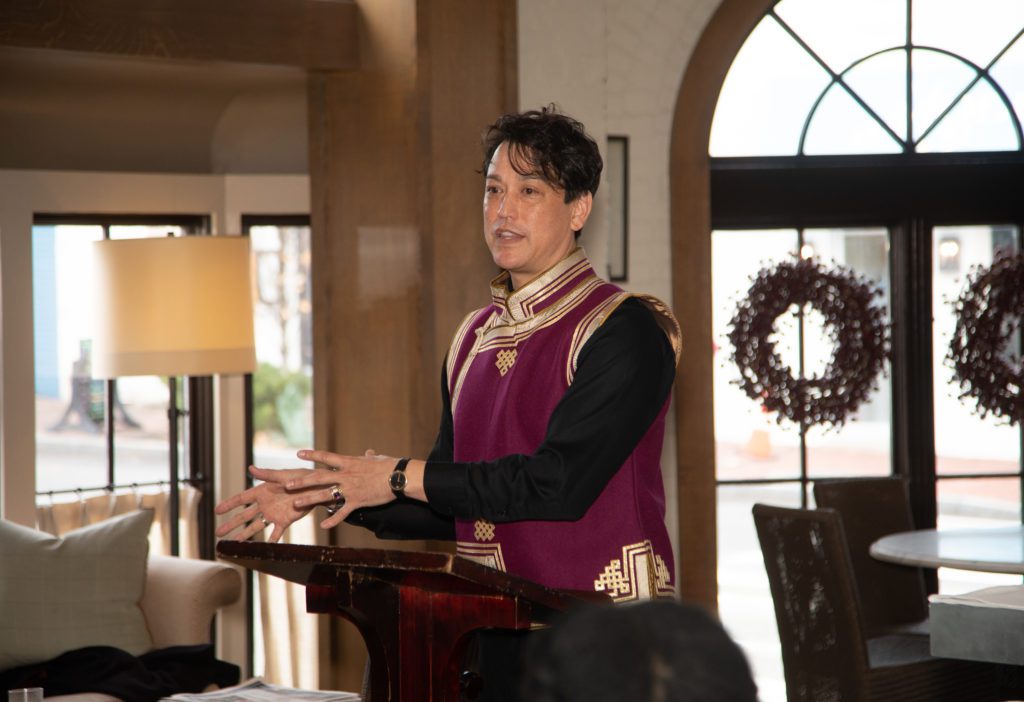Portrait Gallery’s Resident Choreographer Speaks
By • December 10, 2018 One Comment 1027

Choreographer Dana Tai Soon Burgess was teaching a class at the Corcoran College of Art some years ago when a man approached him and asked: “Do you want to dance with a sculpture?”
That man was sculptor John Dreyfuss, who then had his studio in Georgetown’s Halcyon House. It was the start of a collaboration that blossomed into an ongoing relationship with the visual arts for Burgess, who spoke at Georgetown Media Group’s Dec. 6 Cultural Leadership Breakfast.
As choreographer-in-residence at the Smithsonian’s National Portrait Gallery, he now creates several works a year inspired by exhibitions and performed at the museum by the nonprofit Dana Tai Soon Burgess Dance Company.
These works have included “Confluence” about the gallery’s “Dancing the Dream” exhibition, “After 1001 Nights” about “The Face of Battle,” “I Am Vertical” about “One Life: Sylvia Plath” and most recently “Silhouettes.” Next year, Burgess will choreograph a new work based on “One Life: Marian Anderson,” an exhibition opening on June 28 about the legendary African American contralto.
Burgess said that developing these dances and rehearsing them on-site after hours feels like being in a “Night at the Museum” movie. He makes his own choice of which exhibitions to focus on after sitting down with curators and historians to discuss the schedule, reaching out as needed as the choreography progresses.
Apart from exploring how content translates from one art form to another, the purpose of the program is to enliven the visitor experience, in Burgess’s words: “to make sure that the museum is not a dead space.”
This connection to the visual arts actually closes a circle for Burgess. Both his parents were visual artists, but his youthful talent related to movement. A competitive martial artist while growing up in Santa Fe, he discovered dance at age 16 and switched from accounting to dance as a student at the University of New Mexico. In Albuquerque, he studied with former Met Opera Ballet dancer Judith Chazin-Bennahum and joined the company of former Martha Graham dancer Tim Wengerd, who became a mentor.
As a Korean American — descended from Hawaiian plantation workers who were among the first Koreans to come to America — in a largely Mexican American and Native American community, Burgess’s public school years were “one of the most difficult, trying times of my life,” he said. Though he absorbed the “vivid sense of color” and “vivid sense of spirituality” of the desert area he roamed, Santa Fe in the 1970s “was not the Ralph Lauren Santa Fe of the ’80s.”
Those years, however, helped determine the core theme of his early choreography: “the hyphenated story,” about people who are “sort of caught between two worlds.” He later studied the technique of Japanese choreographer and modern dance pioneer Michio Ito, who was interned and deported after Pearl Harbor. Burgess formed his dance company in 1992 while a graduate student at George Washington University, joining the GW faculty in 2000 after directing Georgetown University’s dance program.
His decision to locate in D.C. rather than in New York or Los Angeles — American dance’s creative and commercial capitals, respectively — led to associations with the Kennedy Center and the State Department, for which, as a cultural ambassador, Burgess has traveled with his company to more than 30 countries. “Everyone dances,” he said.
Burgess credited Michael Kaiser, who ran a program at the Kennedy Center to train directors of color, and John Neumeier of the Hamburg Ballet with expanding his vision of what his company and his choreography could become. “To really be able to see what the dream can be is very important,” he said.
This month, Dana Tai Soon Burgess Dance Company will perform “We Choose to Go to the Moon,” a piece Burgess developed in collaboration with NASA, in the National Portrait Gallery’s McEvoy Theater. Performances will take place on Wednesday, Dec. 12; Saturday, Dec. 15; and Tuesday, Dec. 18, at 6:30 p.m. Guest speakers will include National Air and Space Museum curator Teasel Muir-Harmony, National Air and Space Museum geologist Jim Zimbelman and GWU Space Policy Institute founder John Logsdon. Admission is free.


Great write up on his talk and Q&A! Such an interesting personal and artistic journey full of serendipity.